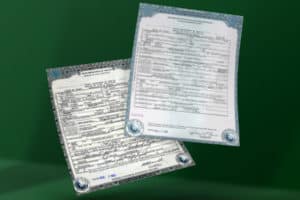Body preservation began long before embalming fluid was developed, but today it’s the go-to option for most funeral homes, despite the negative environmental impact of embalming fluid. Embalming fluid is used to halt the decaying process after death. That requires understanding biochemistry and what leads to decomposition so that it can be counteracted.
The modern-day embalming process involves removing all of the biological fluids in a body and replacing it with the embalming fluid that kills bacteria and microorganisms. That’s largely achieved through the use of a lot of chemicals. With each embalmed body that’s put in the ground there’s growing concern about what happens to embalming fluid and what the ingredients could do outside of a cadaver.
Let’s break embalming fluid down by the different types of ingredients that are used and discuss what they do as well as the risks involved with using them.
Types of Embalming Fluid Influence the Ingredients
In our post on how embalming fluid is used we touched on the fact that there are three primary types of embalming fluid that are formulated differently. The types of embalming fluid are:
- Capillary Washes (Pre-injections) – Used to prep before arterial embalming fluid.
- Arterial – Embalming fluid that ranges from firm to soft that’s injected into the arteries.
- Cavity – Embalming fluid that’s used to fill larger void spaces in the body.
Each one serves a different purpose and is used in different ways. Ingredients are mixed at varying ratios to control the preservation process, but the one constant is some of the ingredients are going to be harsh chemicals.
Common Embalming Fluid Ingredients
Embalming fluids are a cocktail of chemicals. While it is highly regulated, there’s no standard embalming fluid formula that’s used by all funeral homes across the country. However, there are common ingredients that are used to make the different types of embalming fluid. Below is an overview of the ingredients that go into embalming fluids and what they do.
Antibacterial Preservatives
Antibacterial preservatives are the main component of embalming fluid. They slow the progression of decomposition by making the body inhospitable for bacteria growth while also changing enzymes on the body. A combination of preservatives with varying strengths is used depending on a number of factors.
Common embalming fluid antibacterial preservatives include:
- Formaldehyde
- Formalin (aqueous formaldehyde)
- Glutaraldehyde
- Phenol
Germicides
Just like with house cleaning products, germicides in embalming fluid is meant to kill germs in and on the body.
Common embalming fluid germicides include:
- Quaternary Ammonium Compounds
- Glutaraldehyde
Buffers
Buffers are modifying agents that influence the chemical reaction of preservatives in embalming fluid. Specifically, buffers help maintain the pH balance.
Common embalming fluid buffers include:
- Borax
- Sodium Phosphate
- Citrates
- Ethylene Diamine Tetra Acetic Acid
Inorganic Salts
Inorganic salts are another modifying agent in embalming fluid that affects the osmosis (passage) of fluids.
Humectants
The third type of modifying agent in embalming fluid are humectants. It’s used to keep the body tissue hydrated prior to burial or cremation.
Common embalming fluid humectants include:
- Glycerol
- Sorbitol
- Ethylene Glycol
- Propylene Glycol
- Lanolin
Diluents
The diluent is the liquid that all of the chemicals are mixed into. This is why diluents are also called embalming fluid vehicles. Water is a very common diluent as are different types of alcohol.
Anticoagulants
Anticoagulants help keep postmortem blood more viscous.
Common embalming fluid anticoagulants include:
- Sodium Citrate
- Sodium Oxalate
- Sodium salt of EDTA
Surfactants
A surfactant lowers the molecular cohesion so that embalming fluid flows through the body smoothly.
Common embalming fluid surfactants include:
- Alkyl Sulfonates
- Alkyl Aryl Sulfonates
- Sodium Lauryl Sulfate
Coloring Agents
In addition to preserving the body, embalming fluid is used to alter the appearance of a body, especially if someone died from an illness or injury that affected how they looked naturally. Coloring agents (dyes) are used to add color to the embalming fluid so that it’s a specific hue.
Common embalming fluid coloring agents include:
- Eosin
- Ponceau Red
- Erythrosine
- Amaranth
Deodorants
Because of all the harsh chemicals, embalming fluid has a very strong odor. Deodorants are used to mask the chemical smell.
Common embalming fluid deodorants include:
- Benzaldehyde
- Oil of Cloves
- Oil of Sassafras
- Methyl Salicylate
The Risk of Using Harsh Embalming Fluid Ingredients
Now that you’re aware of all the chemical ingredients that go into embalming fluid the risk of using it becomes more clear. Simply handling embalming fluids can be hazardous for three reasons:
- Many of the chemicals are known to be dangerous both immediately upon contact and long-term over time. In particular, formaldehyde is a known carcinogen (causes cancer).
- Possible disease transmission. Studies have shown that it is possible for some diseases to transmit from a cadaver to the embalmer who is handling the fluids. There’s been at least one case of tuberculosis infection and HIV has been found in body fluids even after freezer storage for two weeks.
- It leaches into the ground and water. The microorganisms in a deceased body aren’t pathogenic, but the embalming fluid can cause harm to the living. The toxic embalming fluid doesn’t stay contained in the body. Whether a person is buried with embalming fluid in the body or the fluid is disposed of, some of the embalming fluid ends up in the soil and groundwater. It’s gotten so bad there’s evidence embalming fluid could be getting into tap water.
The worst part is all this risk is unnecessary. Embalming fluid isn’t necessary at all whether you want to preserve a body for a traditional funeral or opt for direct cremation without funeral services. There are alternatives to embalming fluid that are much safer for everyone and the earth.
If you’d like funeral services that don’t involve embalming fluid Cremation.Green can help. We specialize in eco-friendly funeral services that are far better for the environment and surviving loved ones. Contact us today to learn more or check out our pre-planning funeral guide for the next steps to take.






